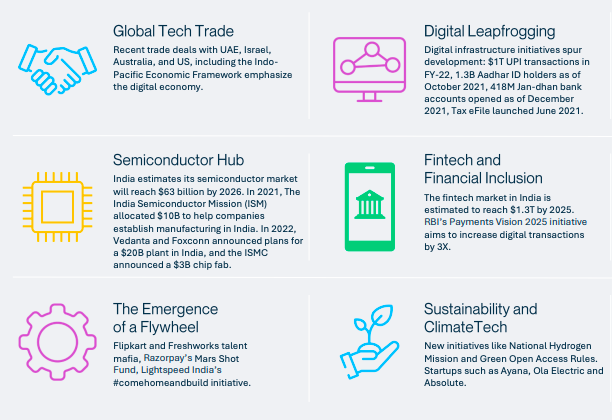A Look at the Technologies and Economics Powering India’s Progress

If you’ve been watching, India’s growth is no surprise.
Over the past decade, innovation and policy have converged to shape an increasingly
entrepreneurial and digitally -enabled India. The confluence of smartphone proliferation, affordable mobile data and the establishment of a widely-adopted digital payment infrastructure rapidly digitized small and mid-size businesses.
COVID only accelerated this trend. In May 2022, India marked its 100th unicorn with a sense of “we’ve arrived,” but this is just the tip of the iceberg. India is a leader in global SaaS — with the likes of Freshworks, ChargeBee, Innovaccer, Uniphore, and Postman— and has a flourishing domestic
technology market: 83% of unicorns serve Indian businesses and consumers.
Foreign direct investment, boosted by reforms and production -linked incentives, reached $84 billion in fiscal year 1 2022. In light of supply chain shocks, companies like Apple
and Samsung are seeking to diversify their respective smartphone manufacturing
by expanding their operations in India. Through production-linked incentives, the Indian
government has taken steps to bolster smartphone manufacturing and establish key
industries such as semiconductors.
India has not been immune to global macroeconomic events such as rising fuel prices
and supply chain congestion. Inflationary pressures prompted the Reserve Bank of India
(RBI) to raise rates, as a result public and private markets pull back.
For the remainder of 2022, we expect muted private investment, lower company valuations, slower
unicorn creation and delayed IPOs. We don’t expect 2022 to exceed last year’s record
$36B of VC investment, but we feel confidant Indian VC investment is on track to
surpass the years prior to 2021.
The below SVB Global Research Report Highlights:
MACRO VIEW: INDIA’S INNOVATIVE ECONOMY
India currently ranks as the sixth-largest economy globally, growing 45% since 2014 with a CAGR1 of 5.4%. Tactical reforms, such as the Make in India initiative, have increased the ease of doing business in a country that has favorable talent demographics.
Over half the population is under 30, and in the 2019-2020 academic year, India had 30.6 million undergraduates, 3.85M are studying engineering and technology.
VENTURE ECOSYSTEM: INVESTMENTS, FUNDS & EXITS
“Indus Valley” was coined by Blume Ventures as a moniker for the Indian Startup ecosystem. It spans from tier-1 cities — major metros designated by population: Bengaluru, Chennai, Delhi-NCR, Hyderabad, Kolkata, Mumbai, Ahmedabad, and Pune — to rural hubs.
Much like the rise of emerging hubs in the US (Atlanta, Austin, Miami), tier-2 cities like Jaipur, Kochi, and Indore are gaining a reputation for their startup scenes. Lower cost of living, access to talent, and a reduction in the digital infrastructure gap have laid the foundations for startups based in tier-2 cities to
thrive.
Local incubators such as TiE-Rajasthan, The Kerala Startup Mission, and Indore Smart Seed act as catalysts providing programming, space, and support.
THE NETWORK EFFECT: INDIA’S GLOBLA PRESENCE
India has the world’s largest diaspora. The UN estimates that 18 million Indians live abroad, and that number nearly doubles to about 32 million when accounting for people of Indian origin. The diaspora has created a global community with shared roots that strongly emphasizes educational
achievement and entrepreneurship.
For example, Indian students make up the second largest international student population in the US,3 and of the 500 unicorns founded in the US between 1999-2019, 90 of the 1,078 founders are Indian immigrants.
These synergies have helped create a network of tech leaders internationally and within India.
2022 & BEYOND: A VIEW FROM THE TOP
GLOBAL TECH TRADE: Recent trade deals with UAE, Israel, Australia, and US, including the IndoPacific Economic Framework emphasize the digital economy.
SEMICONDUCTOR HUB: India estimates its semiconductor market will reach $63 billion by 2026. In 2021, The India Semiconductor Mission (ISM) allocated $10B to help companies establish manufacturing in India. In 2022, Vedanta and Foxconn announced plans for a $20B plant in India, and the ISMC announced a $3B chip fab.
To read the full SVB Global Research Report, see below.
